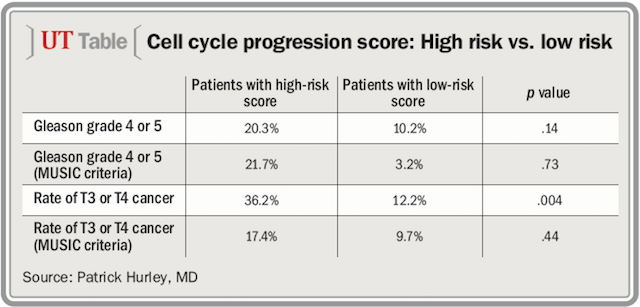Article
CCP score further risk stratifies surveillance candidates
Use of a cell cycle progression genomics test (Prolaris) can further stratify risk in men who are candidates for active surveillance based on clinical criteria, and therefore may have a role in decision-making in men with early-stage prostate cancer, researchers say.
Boston-Use of a cell cycle progression (CCP) genomics test (Prolaris) can further stratify risk in men who are candidates for active surveillance (AS) based on clinical criteria, and therefore may have a role in decision-making in men with early-stage prostate cancer, researchers say.
Among a cohort of men undergoing radical prostatectomy (RP) at a large community-based practice for whom CCP scores were available, high-risk results were more frequent in men with pathologic stage T3 or T4 disease at RP, first author Patrick Hurley, MD, reported at the AUA annual meeting in Boston.
Also see - [Quiz]: Defect observed during RARP
As more men are being chosen for AS, the appropriate clinical question is whether they are being accurately staged, said Dr. Hurley, a urologist at Comprehensive Urology in Novi, MI. Confirmatory tests for men considering AS include a re-biopsy, multiparametric magnetic resonance imaging (mpMRI), and genomic tests. Patients have concerns about re-biopsy, and mpMRI may not be available in the community setting. Also, the post-biopsy accuracy of MRI when the patient has had biopsy hemorrhage is uncertain, he said.

“There is growing interest regarding the extent to which prostate cancer genomic tests can further risk stratify men who are being considered for AS,” he said.
The CCP score is a signature of 31 CCP genes; the score is the average expression level of the CCP genes normalized to 15 housekeeping genes. The study he presented at the AUA annual meeting assessed the utility of the combined risk score, which is the CCP score combined with the CAPRA-S to provide a 10-year estimate of prostate cancer-specific mortality. A low-risk score for the study was defined as a combined risk score <3%. High risk was defined as a combined risk score ≥3%.
Patients undergoing CCP testing between July 2013 and April 2016 at Comprehensive Urology had their CCP scores linked with treatment and pathologic information from the Michigan Urological Surgery Improvement Collaborative (MUSIC) prostate cancer registry.
Some 651 patients had a CCP test result at biopsy, from which 408 had grade group 1 and grade group 2 disease and were therefore considered candidates for AS. Of these, 118 underwent RP as primary treatment. The frequency of adverse pathology was compared between men with high-risk versus low-risk CCP scores. In addition, the rate of adverse pathology was assessed in the 54 patients deemed appropriate for AS via the MUSIC appropriateness criteria, defined as one to three cores positive and no cores containing 3+4 disease with >50% cancer.
Next: High-risk score linked to adverse pathology
High-risk score linked to adverse pathology
Patients in grade group 1 or 2 who had a high-risk score had a much greater chance of having adverse pathology than those with a low-risk score. Gleason grade 4 or 5 cancer was present in 20.3% of the high-risk group compared with 10.2% in the low-risk group (p=.14). Patients in the high-risk group also had triple the rate of T3 or T4 cancer versus those in the low-risk group (36.2% vs. 12.2%; p=.004).
“Possibly more importantly, patients with a low-risk score had <15% chance of having adverse pathology, suggesting they may be good candidates to remain safely on AS,” said Dr. Hurley.
In examining pathology in the group appropriate for AS by MUSIC criteria, the high-risk group via the CCP test had a much higher rate of Gleason 4 or 5 cancer than the low-risk group (21.7% vs. 3.2%; p=.73) as well as double the rate of stage T3 or T4 disease (17.4% vs. 9.7%; p=.44).
Read: Current prostate Ca guidelines miss germline variants
Urologists seemed to be influenced by the CCP test results in choosing patients for AS, Dr. Hurley said. Among patients in grade groups 1 and 2, half of the patients with a low CCP score were chosen for AS, whereas only 14% with a high CCP score were chosen for AS.
“If they were in grade group 1 (Gleason 6 only), there didn’t seem to be any difference, likely because they were going to go on AS anyways,” he said.
“For the patients who are candidates for AS, whether through the MUSIC appropriateness criteria or grade group 1, they were the ones with low-risk scores and low rates of adverse pathology, suggesting that likely they’re safe to remain on AS,” Dr. Hurley concluded.
One of Dr. Hurley’s co-authors is a consultant/adviser for Myriad Genetics, Inc. The study received funding from Blue Cross and Blue Shield of Michigan and a grant from the National Cancer Institute.
More from Urology Times:
RT-ADT combo may boost pN1 prostate cancer survival
Prostate MRI-Bx may ID partial gland ablation candidates
Fusion Bx-guided HIFU shows promise in localized PCa
Subscribe to Urology Times to get monthly news from the leading news source for urologists.
Newsletter
Stay current with the latest urology news and practice-changing insights — sign up now for the essential updates every urologist needs.















